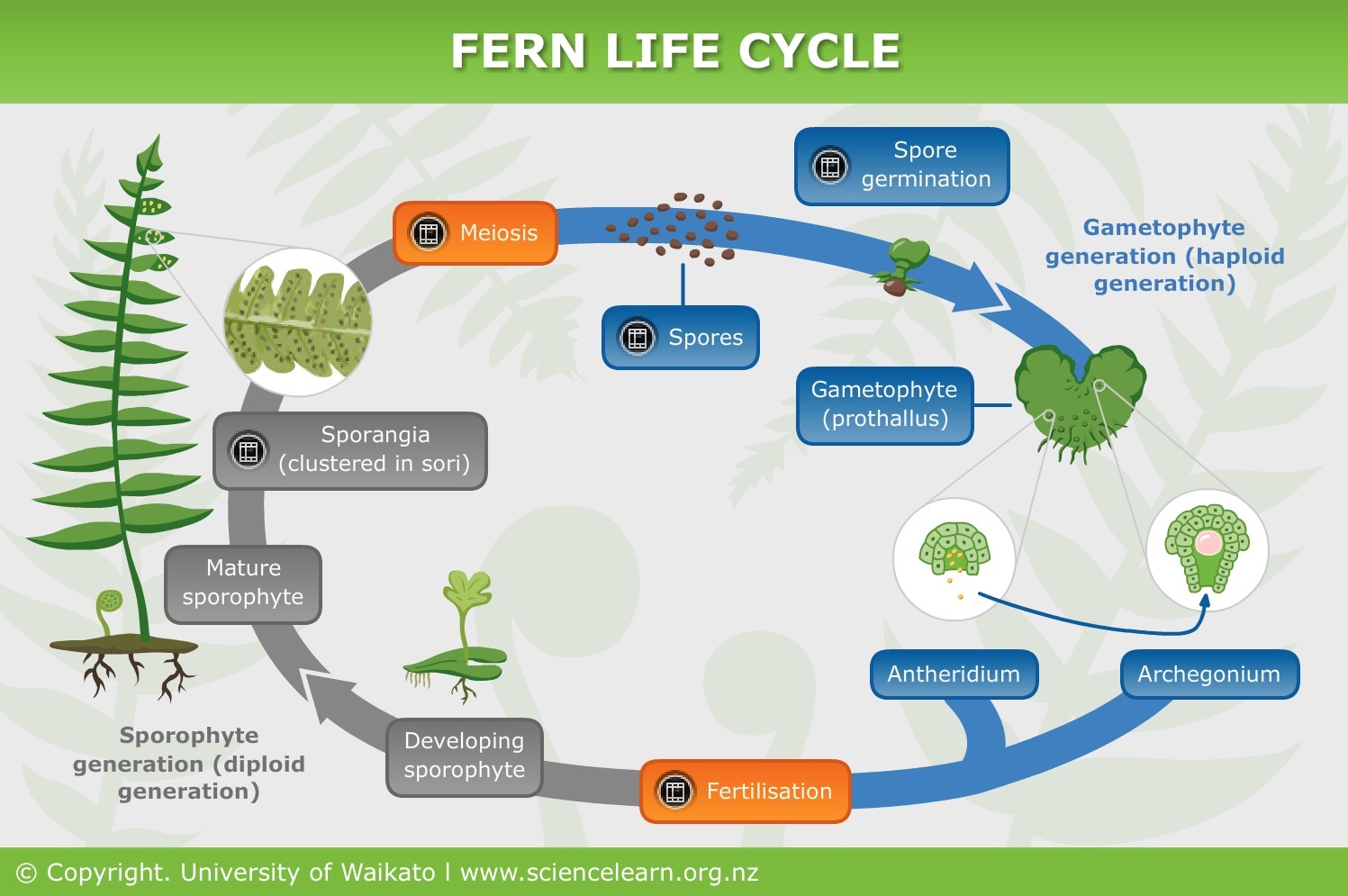Not every plant grows from a seed. Some plants, like ferns and mosses, grow from spores. Other plants use asexual vegetative reproduction and grow new plants from rhizomes or tubers. We can also use techniques like grafting or take cuttings to make new plants.
Plants that reproduce from spores
Ferns are very common in New Zealand. If you turn over a fern frond (leaf), you might see some unusual structures called sporangia. The sporangia produce very tiny spores. Spores are different to seeds. They do not contain plant embryos or food stores. When the sporangia break open, the spores are released and dispersed by the wind. If the spore lands in a suitable environment, it can grow into a tiny plant called a gametophyte.
The gametophyte looks like a little, thin green plate. It does not have roots, stems or leaves. The gametophyte is a short-lived plant that has both male and female reproductive organs. These produce male and female gametes that combine in fertilisation to produce an embryo. Once fertilisation takes place, a new fern plant starts to grow into the plant we recognise as a fern. Ferns are the only land plant that has these two separate independent living stages.
Ferns are not the only plants to reproduce from spores. Mosses, liverworts and green algae also have spores.
Plants that reproduce from asexual vegetative reproduction
New plants are sometimes made by asexual vegetative reproduction. These new plants have exactly the same genes as the parent. Some plants – like strawberries – have stems called stolons that grow out sideways above the soil, and new plants grow up along them. Other plants send out underground stems called rhizomes, which form new plants at a distance from the parent. Tubers (for example, potatoes) and bulbs (for example, onions) are also special underground structures that can grow into new plants.
Grafting and budding
People also make new plants using asexual reproduction. Gardeners grow plants from cuttings. They do this by snipping a young shoot off a plant, dipping it in rooting hormone and placing the cutting in a mixture of sand and potting mix. The cutting soon grows roots and can be transferred outdoors.
Grafting and budding are two ways to make new plants. Fruit tree breeders often use grafting to make new plants. Grafting allows them to have large plantings of the same fruit variety with exactly the same genetic material. Grafting uses the rootstock of a plant that grows well in the soil and joins it to the plant the breeder wishes to produce.
Plant propagation
Vegetative plant propagation covers how plant propagation is the process of increasing the number of plants of a particular species or cultivar. Propagation can be via sexual or asexual means. Over the years, horticulturalists have developed asexual propagation methods that use vegetative plant parts. This allows plants to be created in ways that nature cannot duplicate.
Breeding a new apple cultivar takes a long time and involves many steps, an example of this was the red-fleshed apple variety. Once breeders have developed the desired traits in the apple and the tree, they use vegetative propagation methods (grafting and budding) to reproduce the plants commercially and ensure consistency of the new apple variety.
Nature of science
Although we think of science as always advancing at a steady pace, techniques like cutting and grafting have been around for thousands of years. Science has helped us understand how these techniques work and improve them with advances like rooting hormones and breeding new plant cultivars.
Activity ideas
In this video clip, Parts of a fern, Dr Patrick Brownsey from Te Papa Museum shows us the different parts of a fern. As the language used may be too complex for younger students, consider muting the audio and providing your own simpler narration.
The activity Growing new plants without seeds uses spores, bulbils, rhizomes, stolons, tubers or cuttings to grow new plants.



